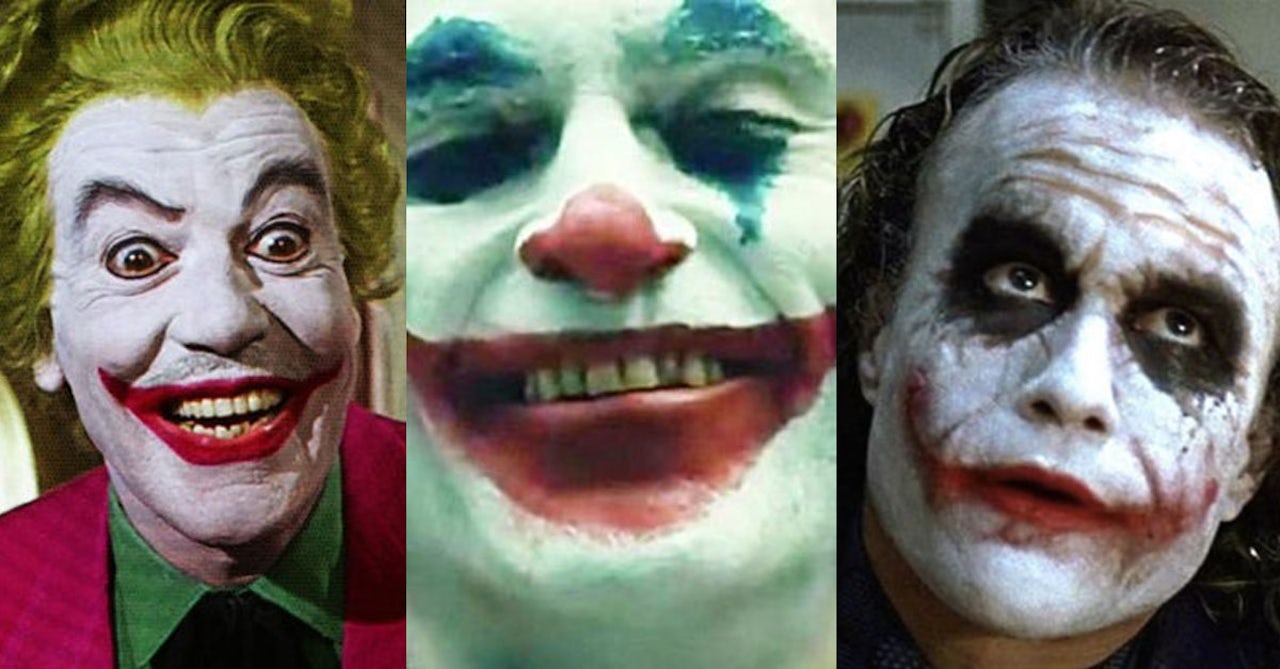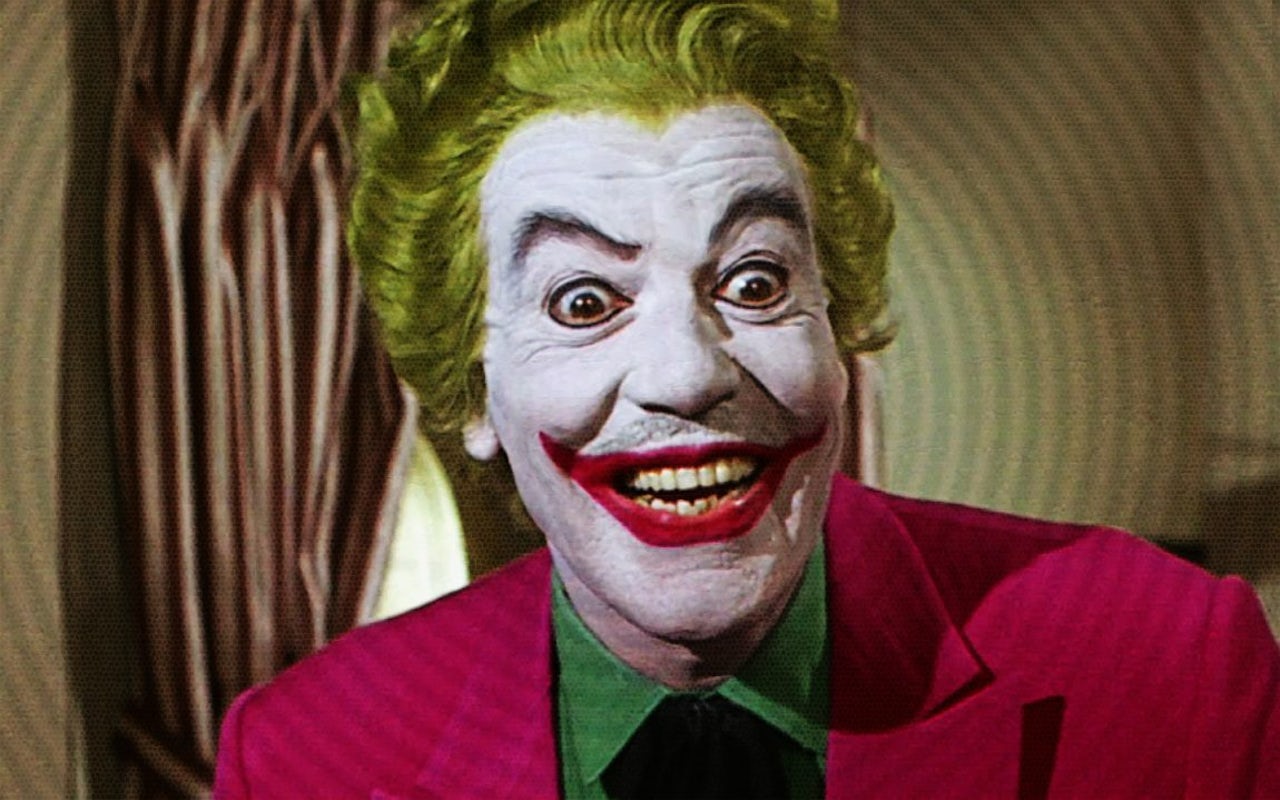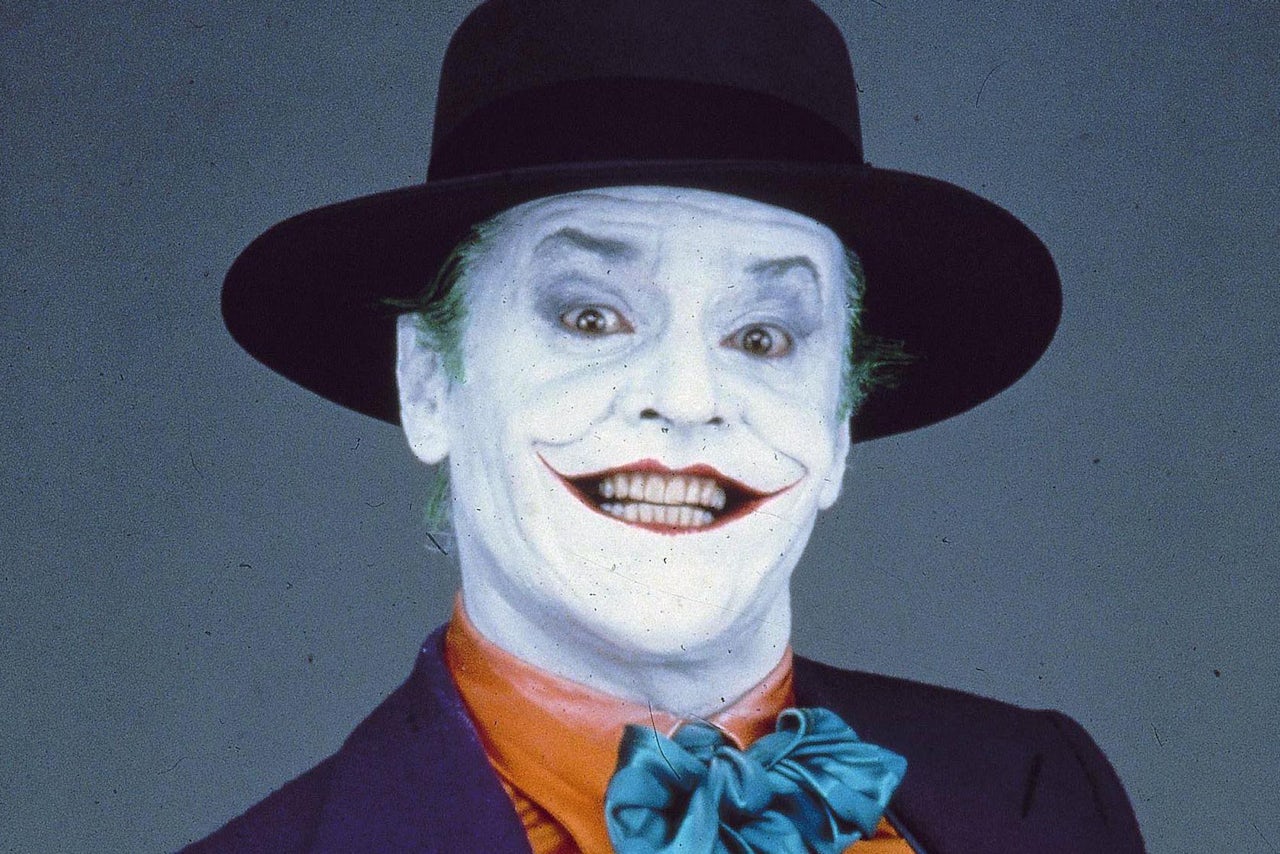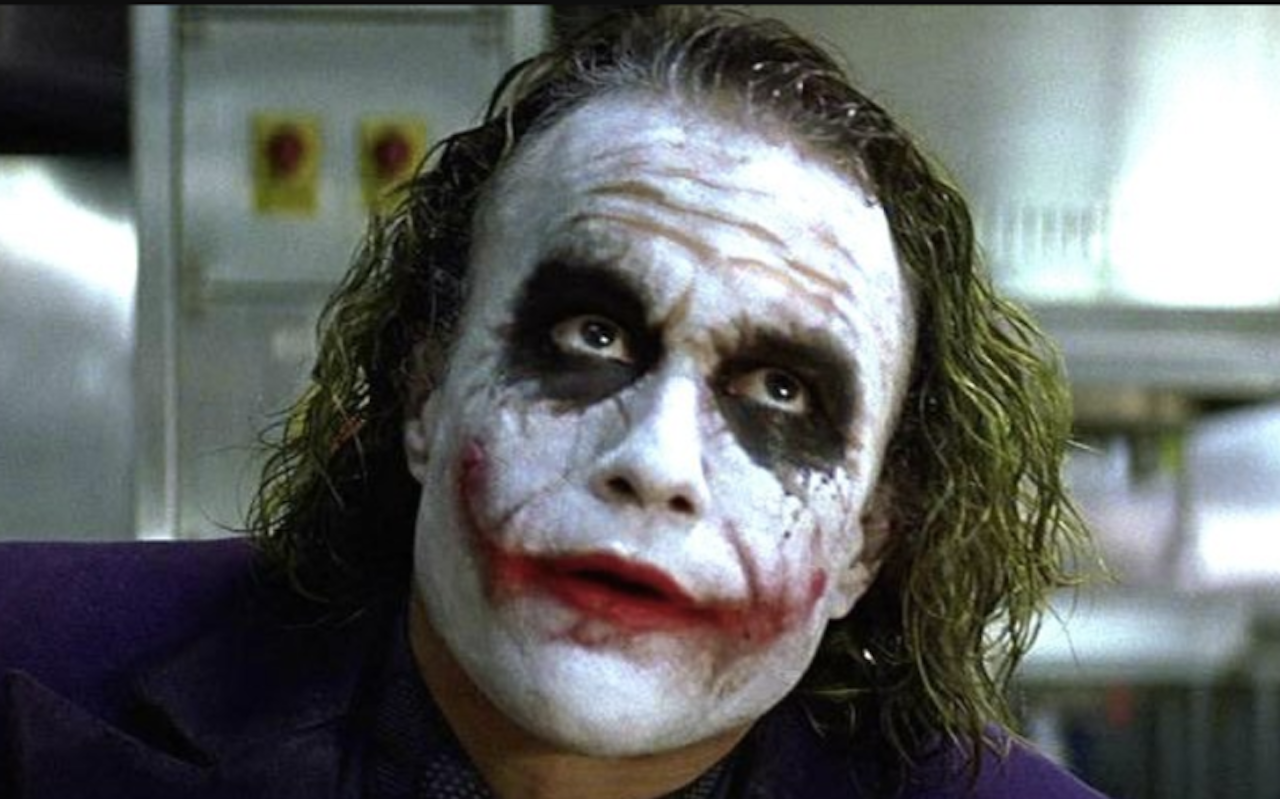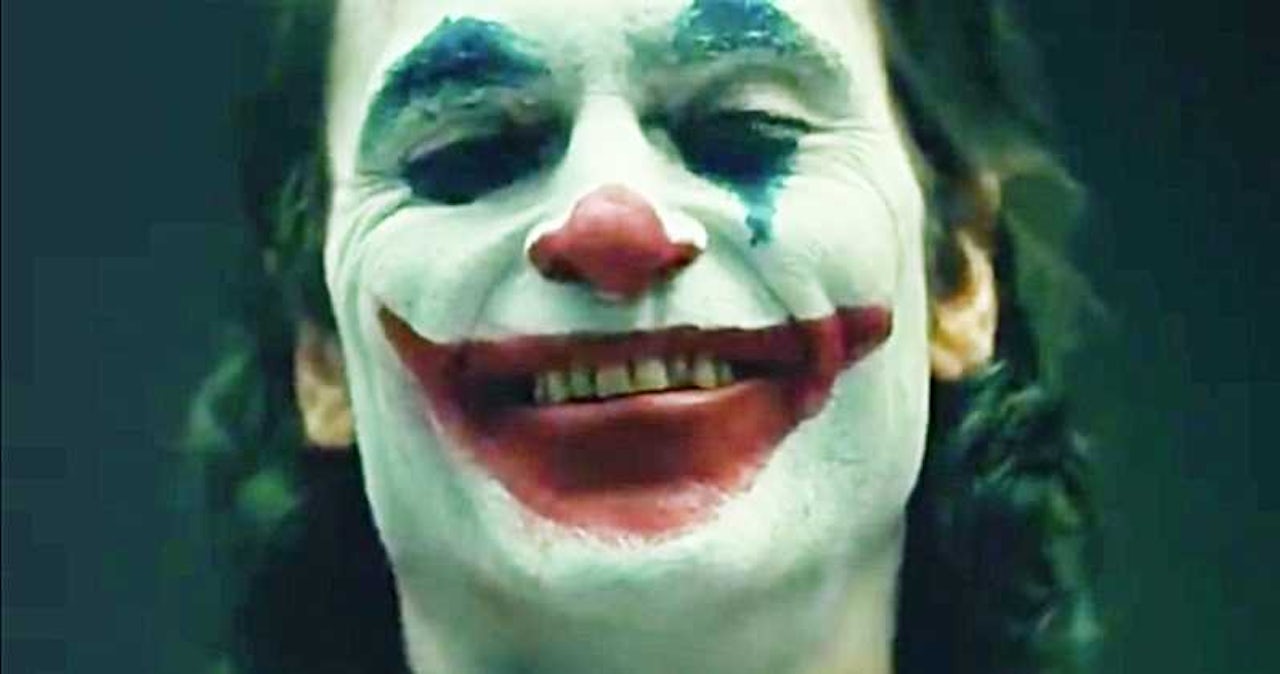Over the weekend, Warner Bros. released the first glimpse of Joaquin Phoenix styled as the Joker, ahead of a planned origin film for the iconic Batman villain set to be released in 2019. As a recut of the Guess Who’s “Laughing” plays, the camera slowly zooms in on a normally dressed Phoenix with flashes of the Joker character overlaid to the strum of the guitar. The view cuts to a few seconds of Phoenix in full makeup — he smiles and raises an eyebrow, before his face returns to a stark expression. There have been manic Jokers, wacky Jokers, campy Jokers, dark Jokers — Phoenix’s, at least for now, looks like a sad Joker.
Of course, this clip inspired a wave of commentary about Phoenix in the role, and yet another round of “Which Joker is the best” conversations. But more importantly: Which Joker is the creepiest clown? And why are clowns so terrifying to begin with? The Outline asked some experts questions about the live-action film adaptations of the Joker, spanning the decades from Cesar Romero to Heath Ledger to Phoenix.
Repost from #toddphillips1:
— Warner Bros. Pictures (@wbpictures) September 21, 2018
Camera test (w/ sound). Joker. pic.twitter.com/R9W2QqKwNS
Why do clowns scare people?
Dr. Frank T. McAndrew, Cornelia H. Dudley Professor of Psychology at Knox College: I think it is not so much that clowns scare people as it is that clowns creep people out. My research on creepiness indicates that it is the uncertainty as to whether or not someone poses a threat that makes them seem creepy. So clowns, who appear to be happy and fun, ought not to be a threat — except that they have very a very weird physical appearance and are outside of the ordinary in so many ways that it makes them unpredictable. After all, if they are willing to violate certain standards of dress and behavior, what other things might they be willing to do?
Dr. Glenn Geher, Professor of Psychology and Founding Director of Evolutionary Studies at the State University of New York at New Paltz: Clowning is among the very few professions in which one’s identity is necessarily de-identified. If you’re a teacher, everyone calls you Mr. or Ms. So-and-so and it’s clear who you are at all times. That is also true if you are a sales clerk (who usually will have a name badge), doctor (who will usually have a large diploma featuring his or her name on the office wall), business person, dentist, lawyer, etc. We like to know who people are. That’s part of the evolutionary design of the human mind.
We don’t know who this person is, and thus we don’t know if this person can be trusted. Many social psychological studies have demonstrated that people are more likely to engage in all kinds of anti-social, nasty behavior when their identities are hidden. Think about members of the KKK and the kinds of atrocities that they have carried out across history. The fact that they wear hoods is no coincidence.
Randy Christensen, Master Clown and professional entertainer and speaker: As as family-friendly performer from the base that wants to help people enjoy the comedy character of clowning, I can say that the horror genre has impacted the general society's view of the lovable, funny, child-friendly clown. I “get” that for many there is a fine line between “fear” and “excitement.” Both can get the heart racing. Both make the adrenaline pump. When one is going to get on a roller coaster, is that person “excited,” or “afraid”? Maybe a little of both. Thus the venues for horror depictions seem to continue to thrive.
Here’s where I have a struggle: I love clowning. I’ve seen so many positive interactions and fun, playful, experiences of wonder happen as a result of good family-friendly clowning. I don’t see that with the “horror character” depictions of clowns. I can’t tell you the numerous times I’ve had people at their first view (before any interaction) say, “I hate clowns.” Honestly, it makes me sad.
What’s creepy about the Joker in particular?
Geher: The Joker is unsettling partly because he is a bad clown. Many people are afraid of so-called “good” clowns. So if you have a scary-looking clown who’s is explicitly and unabashedly evil, I’d say you should be scared of that guy!
The scarred mouth and the blood-like implications of the makeup certainly add to the effect. Under ancestral conditions, blood would have always been a signal of some kind of survival threat. In an immediate sense, blood suggests life-threatening bodily injury. And blood is capable of transmitting various diseases. Add this to the de-identified features of a clown, and there you have it. Scary stuff!
McAndrew: The explicit horror elements add a nice touch. The name itself — “The Joker” — implies harmless, light-hearted fun, and all of the Joker characters have smiles literally painted on their faces, so why wouldn't we think they are happy and harmless? The problem with clowns in general and with the Joker in particular is that the makeup disguises who the person really is, and also disguises what he is really feeling or intending. The incongruity between what we see and what we fear creeps us out.
Christensen: The Joker is quite a conundrum. As an audience member, I can say that Heath Ledger's portrayal was one of my favorite "evil villains" of all time.
Why do you think there’s so much room to play around with the Joker visually?
Evan Narcisse, journalist and Rise of the Black Panther writer: There’s so much room to continually reinterpret the Joker in live-action adaptations because he’s constantly being reinterpreted in the comics. These aren’t always one-to-one homages to stuff that’s been in the comics. In his first 20 years, the Joker changed from being a very dark, ominous criminal to being more of a prankster, then back to being someone who could generally scare you… You go from there to the ‘70s, he’s gone from scary to campy and back to scary again. From then on, it was always a character that new creators wanted to try and put their own stamp on.
Dan Rebert, special makeup, props, and creature effects expert: The Joker’s probably Batman’s most well-known adversary. He’s not like Michael Myers or Jason Vorhees. He's a bad guy that has a lot of character and personality. In terms of changing the look, the Batman movies, the TV series, they varied in tone quite a bit. I mean, Tim Burton’s stuff was more, you know, Tim Burton — a more fairytale/fable kind of version — where Christopher Nolan’s stuff is more gritty and real. So I think the Joker's looks are dictated by the tone of the movie.
Why do artists keep coming back to particular design elements in the Joker’s design?
Rebert: I think the whole look of the Joker came initially from a standard set of playing cards. You would see the Joker through most of the movies and TV shows leaves a playing card. In terms of kind of keeping with that prop element and that storytelling element that they use, they're kind of locked in. Everyone knows what a joker looks like in a deck of playing cards, so you kind of have to start with that as as a baseline.
Narcisse: The white skin is a constant because it makes him seem ghastly, phantasmagorical, and otherworldly. It makes him seem obviously like a circus clown, right, but the way it’s presented with the joker is like, oh, this is not just face paint; this is all over his body. This guy is he’s like an avatar of death. The green hair, you know, obviously has circus clown influences — but you know, there’s an element of sickliness to that particular color choice, communicating that he’s outside the normal moral parameters that we all operate in. I think the idea about his visual appearance is always to be like, this is a guy outside of society’s boundaries.
Cesar Romero (1966’s Batman: The Movie)
Geher: I grew up with this one!
Rebert: The original Batman TV show was kind of campy and fun. I honestly don't think they put a lot of thought into what the Joker design would be like. Probably the guy who did the makeup found out about it that day like “Hey, put a Joker makeup on this guy.” It's not like today where hundreds of thousands of dollars are spent with artists designing what the Joker's going to look like for their big-budget movie. It was fine for the tone of the show. I really don't think much thought was — I don't think there was meetings being held about how the Joker's makeup was on the 1960s show.
McAndrew: Cesar Romero's Joker is the least creepy. It is almost cartoonish, and in keeping with the campiness of the Batman show he appeared on, the creep factor has been dialed down.
Christensen: From a professional clown's approach, this makeup design works because he uses the normal features that move on a face. He's a jokester who's over-exuberance is displayed through his bright eyes and laughing smile.
Narcisse: I like the Cesar Romero Joker a lot. He was the first one I remember seeing in live-action. I think the reason his performance endures — and one of the things I liked most about it — is because it’s a reminder of the Joker’s theatricality; he played it big, he played it broad, he played it slightly manic, and it was a reminder of how the character was portrayed in the comics. Because the Joker always had these elaborate schemes, and he wanted attention, and Romero played that character. There’s the inherent goofiness of painting over his mustache because he didn’t want to shave it for the role, which feels like this weird meta joke, which it probably wasn’t at the time but, as the decades have passed, has become one, and I think that’s always hilarious when you look at him playing that part. This may be a marker of how old I am, but whenever I see his picture, I think of the musical stinger that was associated with him in the TV show — and it was always like, you knew some Joker shit was about to pop off, and it was gonna be very funny.
Jack Nicholson (1989’s Batman)
Christensen: Jack Nicholson's makeup design is clean, clear-cut, specific. Historic traditionalists still say the "whiteface clown" is the one that takes charge and gives the orders. He is mischievous, but he's in control.
Rebert: Without a doubt, the makeup on Jack Nicholson, which was designed by Rick Baker, is technically the best and most elaborate Joker makeup we've seen. It involves facial prosthetics, and also facial prosthetics that incorporate pull tabs into the corners of his mouth so his mouth’s actually distorted with prosthetics covering that rig. Everything about it is technically perfect. It's a high-end makeup. It works — Jack Nicholson was able to speak and show emotion through it. He hated wearing it. So yeah, [on a technical level], that is the best one. As a makeup artist, I really don't know that you can do a makeup like that any better than it was done on Jack Nicholson.
Geher: Cannot get creepier than Jack!
Narcisse: The Jack Nicholson version of the character from the Burton movie was interesting because it was really garish, you know, that smile seems painful. You always talk about the rictus of death, and it always seemed like his face was stuck like that, and it made it seem really frightening. The thing about Jack Nicholson’s portrayal is that he made the Joker feel primal — like this force of nature that was always bubbling inside one man or multiple people that just came out after his encounter with the macabre, with Batman — like a spirit that haunts you. There was some slapstick and some bigger broader notes in his performance, but there was this weird undercurrent of him tapping into something primeval that was creepy.
McAndrew: Nicholson’s Joker is more of a self-interested psychopath that in many ways is more predictably evil and dangerous—but maybe not as creepy. He is probably the most Donald Trumpish of the group.
Heath Ledger (2008’s The Dark Knight)
Christensen: This Joker image barks something totally different from Nicholson's. This guy is rough and on the edge. Nicholson's makeup application was pristine. Ledger's shows an out-of-controlness and commitment to nonconformity with this patchy smearing. There are no fine lines... which is also a clear portrayal of his psyche.
Narcisse: It’s so hard to talk about Heath Ledger because it set this ridiculous standard for everything that followed, you know? This Joker does not seem mentally unstable—he seems calculated; despite the fact that he says he doesn’t plan things, his methodology may not be calculated but his end goal — to sow chaos — is. Everything about the approach to the makeup for him — his hair, his clothes — he seemed like he could have rolled off the street. But at the same time, the fact that you don’t know anything about his origins makes him seem more scary. That’s one of the boldest things that Nolan did with that movie. He just shows up, like he’s always been around.
McAndrew: Heath Ledger's seems genuinely troubled and perhaps mentally deranged, making him more of a potential danger. The character is very dark.
Rebert: Heath Ledger as the Joker is probably my favorite and probably the only movie I really liked with the Joker in it. The makeup’s fairly simple but very well done. It's very grounded in realism with more natural scarring. I also like the fact that it's really messy — it really comes off like he did it himself, which is harder to pull off than you may think because we're so used to doing controlled stuff. And when you're trying to do controlled mess and match it in continuity every day — I mean definitely, that makeup deserves credit. It's a more difficult makeup than it would come off, and I'm not saying that because the prosthetics — the prosthetics on it are pretty prosthetics 101 — but keeping that continuity and keeping that look that is an insane man is putting this on his face you know. So I think the makeup is very well done. As a character, that was definitely the scariest Joker. I was never scared of the Joker in any other movie.
Jared Leto (2016’s Suicide Squad)
Narcisse: The Jared Leto iteration is my least favorite so far. It just seems so calculated — like it’s an edgelord, try hard conglomerate of what an outsider, dangerous identity is supposed to look like. You have diamond fronts, this garish tattoo work that is all way too didactically self-obsessed. The Joker doesn’t tattoo “Joker” on his own face or body. He doesn’t tattoo the messages about who he is on his own body. His actions and his words do that. You know what I’m saying? It just seems really try hard. It just didn’t move me that much. He just didn’t have that kind of like je ne sais quoi that makes a good Joker performance. He never really seemed unhinged. The truest note he struck in his performance was him being a dick to Harley, and even that is a latter-day layer added to the character added from Batman: The Animated Series. Everything else was like, you’re being a crime lord in the exact same way that other crime lords have done this in cinema. There’s a little bit of Scarface there, a little bit of Al Capone, but the Joker’s supposed to be more than that.
Christensen: Makeup is unnecessary. He chooses to put it on like a person chooses to wear a hat. It's simply an accessory he chooses to use when he wants as a demonstration to the public: like someone changing lipstick or eyeshadow. For him, it's about style more than a necessity. Some say that when one puts on the clown makeup, it allows a person to "let the real you out without inhibition." With Leto, that can be a scary thing.
Geher: Ick — too creepy!
Rebert: You know, I thought that was just fine. I know a lot of fans had a lot of outcry because it kind of went in a completely different direction than anything we've seen before. Personally, I didn't mind it. I didn’t think it worked poorly in the movie. The DC movies seem to be a little all over the place in terms of — it’s really hard to blame any makeup or any actor for anything going on in a DC movie. It was done well and probably fits with more of what kids today are looking for in the look of a bad guy. I mean, I grew up in the ’80s. If you were to put something like that out in the ’80s, you know, church groups would have been going berserk. It would have been way too kind of homoerotic — the Batman movie would have been playing at midnight on a double bill with Rocky Horror Picture Show.
Joaquin Phoenix (2019’s Joker)
McAndrew: [Phoenix’s Joker] presses all the same buttons as the Ledger Joker.
Narcisse: What I hope is that they just really go far field here. It’d be great if this movie didn’t have Batman at all. The challenge facing DC and Warner Brothers now is that they have to break from a formula that has failed to find its footing and move toward something that’s more auteur-driven, probably, and gives people something that they haven’t seen, or at the very least an amalgam of stuff that’s interesting unto and of itself, not just because it reminds you of the comics—something that feels like it’s coming from somewhere else. There’s an old Denny O’Neil quote from decades back: “You have to bring something to comics from outside of comics.” That’s what I hope this Joaquin Phoenix movie does. The look is interesting because it feels like it’s out of a sad clown painting from like the ’60s — those kitschy paintings that are also like, a little bit scary, like a little bit of John Wayne Gacy in there — it looks like it’s gonna be a retro, ’70s grindhouse-influenced affair. I just hope it manages to be surprising.
Christensen: Blotchy makeup application. Shows a lack of control... also one that has "no lines." It'll be interesting to see how this character hits the screens.
Rebert: It kind of goes back to what they were doing with Heath Ledger with looking like an insane man is putting the makeup on himself Comparing the two side by side as makeups, I definitely like the Heath Ledger one better. It looks rougher and dirtier, and it looks scarier. I'm curious to see what Joaquin Phoenix does with it, though. As a makeup, it's obviously nothing technically hard, what's on Joaquin Phoenix, but what he does with it, what he brings to life with it, I think, could really change the way audiences perceive that makeup. I just hope they have a good script for him.
